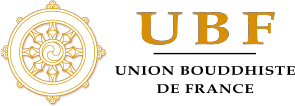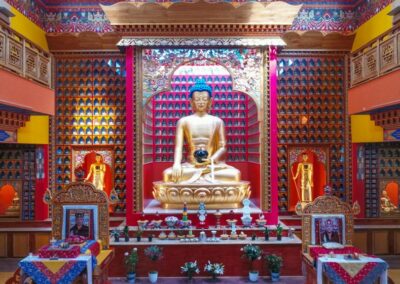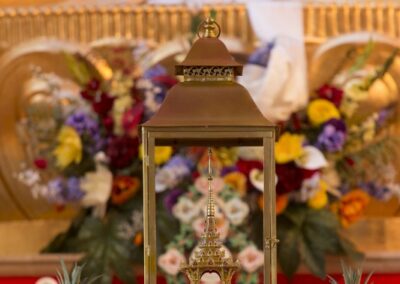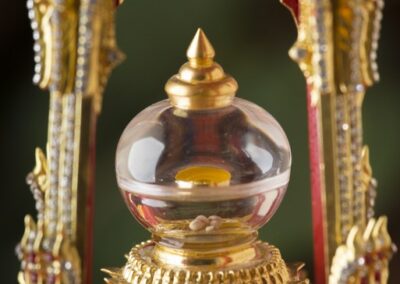Exceptional event
The Relics of the Buddha
From 21 to 27 August 2025
22, 23 and 24 August 2025
Free access
Exceptional event
The Relics of the Buddha
From 21 to 27 August 2025
22, 23 and 24 August 2025
Free access

Event
In partnership with the French Buddhist Union (UBF), Dhagpo Kundreul Ling has the immense honour of welcoming the Relics of the Buddha, which were donated to France and are housed at the Grande Pagode de Vincennes. The Buddha of our time, Shakyamuni Buddha, attained Enlightenment more than 2,500 years ago, thus achieving a state of profound peace, beyond all suffering. This exceptional exhibition of his Relics offers a unique opportunity to connect with his spiritual influence.



Programme
The Relics will be on display in the main temple of Dhagpo Kundreul Ling:
Thursday 21 August: procession for the arrival of the Buddha’s relics at 3pm
Friday 22 and Saturday 23 August: free access from 10am to 10pm
Sunday 24, Monday 25 and Tuesday 26 August: free access from 2pm to 7pm
During this exhibition period, there will be continuous recitations of prayers as well as ceremonies, offering practices, interfaith exchanges, teachings, and free visits to the centre.

Visit
- Free visits of the temple with audio guide for this event (languages available: French, English, German).
- Free access to the park and bamboo grove.

Practical information
Relaxation and dining area: a crêperie and tea room welcome you by a pond 3 minutes by car from the temple. Food is available for lunch and snack breaks. Advance reservations can be made by calling: +33 4 73 52 57 20.
Soujata shop: the centre’s shop offers a wide selection of books and handcrafted products.

Picnic area: accessible all year round
Parking: parking is available on site for cars and motorcycles only.

Learn more
What is a relic?
Relics in Buddhism
This episode of Sagesses bouddhistes is dedicated to the subject of relics. What is the history of these relics? What forms can they take?
Traditionally, a relic, sharira in Sanskrit or ringsel in Tibetan, is a small bead found in the ashes of an enlightened being after cremation. It can also be bone fragments or parts of the body found intact. In addition to bodily relics, objects and clothing that belonged to a noble being are also considered relics.
A bit of history: the Relics of the Buddha
Because you, ultimately, had not perished,
And so that future beings may develop merit,
You emanated many relics and allowed
Your sacred remains to be divided into eight parts: to you I pay homage.
The Buddha died in Kushinagar, India. When he entered parinirvana—the death of an enlightened being—his body was cremated. After the cremation, his relics were divided into eight parts and distributed to representatives of the various Indian kingdoms of the time, who placed them in reliquary stupas.
In India, at the end of the 19th century, the collapse of a stupa belonging to the Shakya clan – the Buddha’s family – led to the discovery of relics of the historical Buddha, preserved for more than two millennia. At that time, India and almost all of Asia were colonised. The precious relics were therefore entrusted to Thailand, the only Buddhist country spared from colonisation, and placed in the Temple of the Golden Mountain in Bangkok. In the Buddhist year 2442 – 1898 according to the Western calendar – a prediction revealed that the relics would leave Thai soil for the West 111 years later.
The arrival of the Relics of the Buddha at the Grande Pagode and Kagyu Dzong
Part 1
Part 2
In 2009, 111 years later, the Thai Patriarchs, with the approval of the Asian Buddhist community, decided to offer the relics to the Western world and entrust them to a European country, a new land of asylum. Their choice fell on France, the country of human rights, and more specifically on the city of Paris, a symbol of the dynamism of European Buddhism. The relics were officially entrusted to the Buddhist Union of France, which ensured their reception and conservation.
The Benefits of the Relics
So, dear Dharma friends, please take this unique opportunity to receive blessing by generating aspirations in the same way as Buddha Shakyamuni. His aspirations are perfectly condensed and summarized within the Samantabhadra Aspiration Prayer, also known as the King of Aspiration Prayers. So whether you are close to these precious relics or far away, recite this text to accumulate merit and wisdom. By doing so, you will establish a precious connection between the Buddha’s enlightened aspirations and your own.
The Relics of Shakyamuni Buddha, a tangible reminder of his manifestation in our world, connect us to his spiritual influence. Meditating, reciting prayers of aspiration, prostrating before them, or circumambulating them connects us to the timeless aspirations of the Buddha. The benefits of being in the presence of relics are numerous, both on the relative level of our existence, such as benefiting from favourable conditions, and on the more ultimate level, by supporting our path to liberation from suffering.




